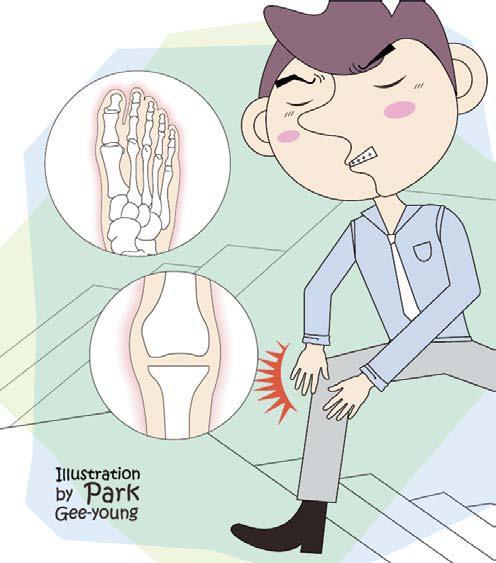Gout, the disease of kings?
Published : 2010-12-13 17:55:51
Gout is a painful condition caused by elevated levels of uric acid which crystallize and are deposited in joints, tendons and surrounding tissues.

Gout was first identified by Egyptians in B.C. 2640 and was later recognized by Hippocrates in B.C. 5th century who referred to it as “the unwalkable disease.”
Gout is often called “the disease of kings” because of its association with the rich food and copious alcohol intake that, at least in the past, was available only to aristocrats.
Nowadays, gout strikes many people of all social and economic backgrounds.
The disease usually appears in men between the ages of 40 and 50, and postmenopausal women, although it can occur earlier or later.
While diet is a factor in the development of gout, a condition known as hyperuricemia is really the primary risk factor for gout. Hyperuricemia is a medical term which describes high blood levels of uric acid.
The body breaks down proteins and purines during digestion which are then converted into a waste product called uric acid.
Normally uric acid passes out of the body through the kidneys in urine.
However, if a diet heavy in purines causes the body to produce more uric acid than the kidneys can eliminate, a condition called hyperuricemia develops.
Despite low purine consumption, however, some people may still develop hyperuricemia because of decreased capacity of their kidneys to eliminate uric acid either due to medications such as diuretics, or genetic factors.

Only about 10 percent of gout cases are caused by overproduction of uric acid. The other 90 percent generally produce normal levels but excrete too little of it in their urine.
High blood uric acid level can cause sudden and recurrent attacks of pain and swelling in the joints that are caused by the deposition of needle-like uric acid crystals in some joints, most notably the big toe, but the disease can also strike the knee, ankle, foot, hand, wrist and elbow.
Not everyone with hyperuricemia develops gout, however.
It is only a small portion of those with hyperuricemia that develop gout during their entire lifetime.
Although you may never contract gout, the odds of doing so increase with the amount of time that your uric acid level remains high.
Although the way the kidneys process uric acid in the body may be of greater importance than what and how much purine is eaten, reducing the intake of food such as meat and seafood, consuming adequate vitamin C, limiting alcohol and fructose consumption (high in soft drinks) can be helpful in lowering the blood levels of uric acid.
Ultimately, it is the blood level of uric acid which is the most accurate way to predict future attacks in those with previous gout attacks.
Even without any treatment, an acute attack of gout will usually resolve in five to seven days. However, 60 percent of people will have a second attack within one year.
Gout does have the potential to progress to other joints and can eventually lead to joint damage.
However, with proper care and treatment, symptoms of gout are very manageable.
There are many different types of treatments available, including medications to ease pain, and medications which may help to prevent future flares.
By Lee Jaejoon, M.D.
The writer is clinical assistant professor of rheumatology at Samsung Medical Center. ― Ed.

Gout was first identified by Egyptians in B.C. 2640 and was later recognized by Hippocrates in B.C. 5th century who referred to it as “the unwalkable disease.”
Gout is often called “the disease of kings” because of its association with the rich food and copious alcohol intake that, at least in the past, was available only to aristocrats.
Nowadays, gout strikes many people of all social and economic backgrounds.
The disease usually appears in men between the ages of 40 and 50, and postmenopausal women, although it can occur earlier or later.
While diet is a factor in the development of gout, a condition known as hyperuricemia is really the primary risk factor for gout. Hyperuricemia is a medical term which describes high blood levels of uric acid.
The body breaks down proteins and purines during digestion which are then converted into a waste product called uric acid.
Normally uric acid passes out of the body through the kidneys in urine.
However, if a diet heavy in purines causes the body to produce more uric acid than the kidneys can eliminate, a condition called hyperuricemia develops.
Despite low purine consumption, however, some people may still develop hyperuricemia because of decreased capacity of their kidneys to eliminate uric acid either due to medications such as diuretics, or genetic factors.

Only about 10 percent of gout cases are caused by overproduction of uric acid. The other 90 percent generally produce normal levels but excrete too little of it in their urine.
High blood uric acid level can cause sudden and recurrent attacks of pain and swelling in the joints that are caused by the deposition of needle-like uric acid crystals in some joints, most notably the big toe, but the disease can also strike the knee, ankle, foot, hand, wrist and elbow.
Not everyone with hyperuricemia develops gout, however.
It is only a small portion of those with hyperuricemia that develop gout during their entire lifetime.
Although you may never contract gout, the odds of doing so increase with the amount of time that your uric acid level remains high.
Although the way the kidneys process uric acid in the body may be of greater importance than what and how much purine is eaten, reducing the intake of food such as meat and seafood, consuming adequate vitamin C, limiting alcohol and fructose consumption (high in soft drinks) can be helpful in lowering the blood levels of uric acid.
Ultimately, it is the blood level of uric acid which is the most accurate way to predict future attacks in those with previous gout attacks.
Even without any treatment, an acute attack of gout will usually resolve in five to seven days. However, 60 percent of people will have a second attack within one year.
Gout does have the potential to progress to other joints and can eventually lead to joint damage.
However, with proper care and treatment, symptoms of gout are very manageable.
There are many different types of treatments available, including medications to ease pain, and medications which may help to prevent future flares.
By Lee Jaejoon, M.D.
The writer is clinical assistant professor of rheumatology at Samsung Medical Center. ― Ed.
http://www.koreaherald.com/common/newsprint.php?ud=20101209000947